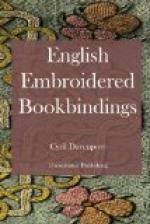Udall, Sermons. London, 1596.
A few specimens of embroidered books were exhibited at the Burlington Fine Arts Club in 1891. Among them was a charming velvet binding that belonged to Queen Elizabeth, lent by S. Sandars, Esq., and now in the University Library, Cambridge. It is a copy of Udall’s Sermons, printed in London in 1596, and is covered in crimson velvet, measuring about 6 by 4 inches. The design is the same on each side, the royal coat-of-arms applique, with the initials E. R., and a double rose in each corner with stalks and leaves. The coat-of-arms is made up with pieces of blue and red satin, the bearings heavily worked with gold thread, and the ground also thickly studded with small straight pieces of guimp, doubtless put there to insure the greater flatness of the satin. The crown with which the coat-of-arms is ensigned is all worked in guimp, and is without the usual cap. The ornaments on the rim are only trefoils, and there are five arches.
The initials flanking the coat are worked in guimp, as are the corner roses and leaves. The guimp used is apparently silver, and the cord used for the outlines and stems is gold. The back has a gold line down the middle and along the joints, with a wavy line of gold cord each side of it.
[Illustration: 29—Collection of Sixteenth-Century Tracts.]
Collection of Sixteenth-Century Tracts. Bound about 1610.
To Henry, Prince of Wales, we owe a great debt of gratitude, as he was the first person of much consequence in our royal family to take any real interest in the Old Royal Library.
Indeed it may be considered that the existence to-day of the splendid ‘Old Royal’ Library of the kings of England, which was presented to the nation in 1759 by George II., is largely due to the attention drawn to its interest and value by Prince Henry, who moreover added considerably to it himself.
This Prince used as his favourite and personal badge the beautiful design of three white ostrich feathers within a golden coronet, and with the motto ‘ICH DIEN’ on a blue ribbon. With regard to the origin of this badge there is unfortunately a good deal of obscurity. The usual explanation is that it was the helmet-crest of the blind king of Bohemia, who was killed at Crecy in 1346, and that in remembrance of this it was adopted by the Black Prince as his badge. But, as a matter of fact, the ostrich feather was used as a family badge by all the sons of Edward III. and their descendants. It appears to have been the cognisance of the province of Ostrevant, a district lying between Artois and Hainault, and the appanage of the eldest sons of the house of Hainault. In this way it may have been adopted by the family of Edward III. by right of his wife, Philippa of Hainault.
An early notice of the ostrich feather as a royal badge occurs in a note in one of the Harleian MSS. to the effect that ’Henrye, son to the erle of Derby, fyrst duke of Lancaster, gave the red rose crowned, whose ancestors gave the fox tayle in his proper cooler, and the ostrych fether, the pen ermine,’ the Henry here mentioned being the father of Blanche, wife of John of Gaunt.




